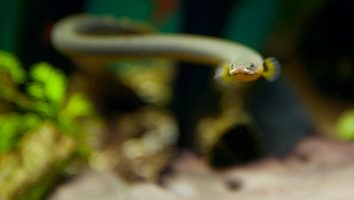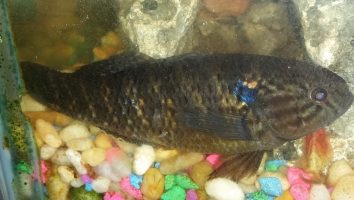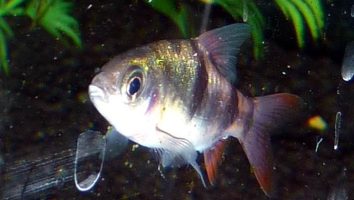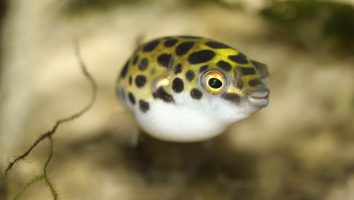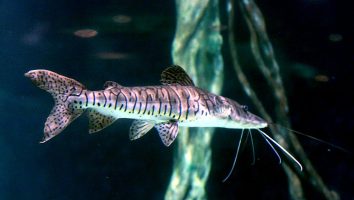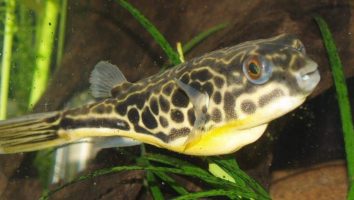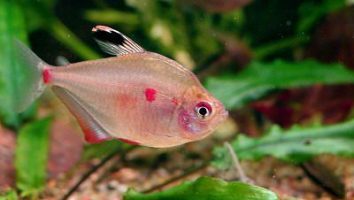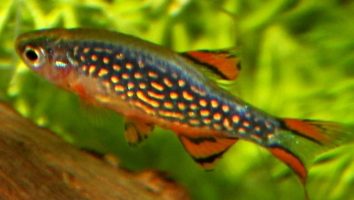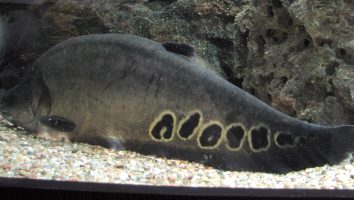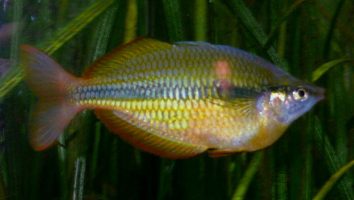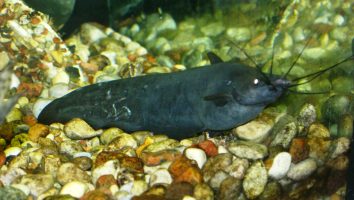The keyhole cichlid is a peaceful and beautiful freshwater fish that is perfect for beginners. They are easy to care for and make a great addition to any community tank.
This guide will teach you everything you need to know about keyhole cichlid care. You’ll learn about their diet, size, lifespan, and more!
Table of contents
Species overview
The keyhole cichlid (Cleithracara maronii) is a freshwater fish that’s native to Guyana, Suriname, and French Guiana in South America.
They are found in slow-moving rivers and streams with a lot of vegetation. The water in these areas is typically stained or murky, which is something that the keyhole cichlid is quite used to.
Due to their small size, keyhole cichlids are a popular choice for nano aquariums. They are peaceful fish that can get along with a wide variety of tank mates.
The main thing that sets keyhole cichlids apart from other fish is their unique coloration. They are black with white spots, which creates a very striking contrast.
Appearance
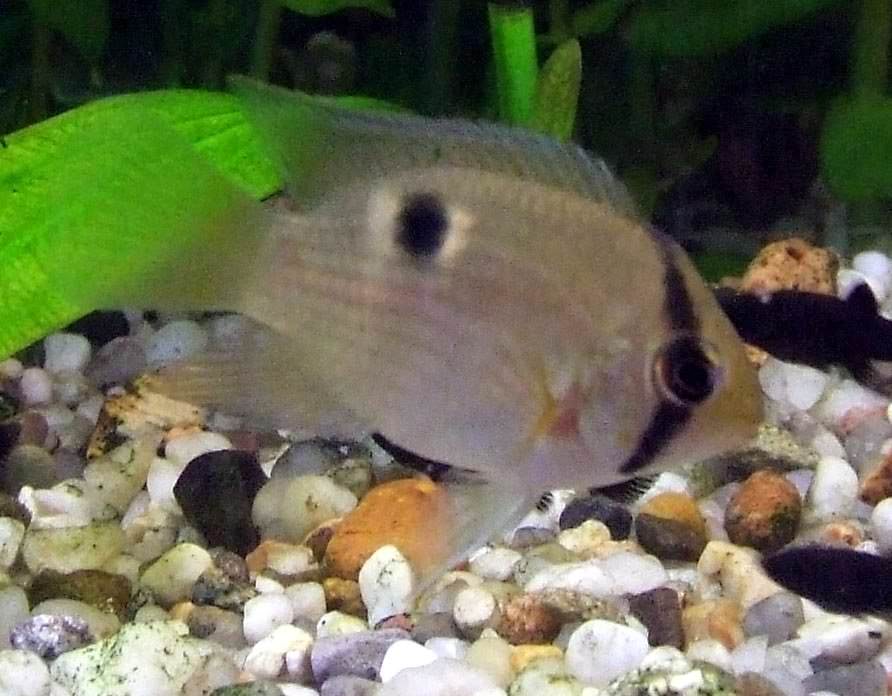
The Keyhole cichlid is a beautiful freshwater fish that is perfect for intermediate aquarists. They have a unique color pattern and a long body shape that is sure to stand out in your tank.
The body of the Keyhole cichlid is long, thin, and torpedo-shaped. They have a slightly compressed body that is covered in small scales.
The color pattern on this fish is very unique and eye-catching. They have a dark brown or black base color that is covered in small white spots.
The dorsal fin and the caudal fin are both dark brown or black with white spots. The anal fin and the pectoral fins are both clear.
The most distinctive feature of this fish is the “keyhole” shaped marking on their forehead. This marking is dark brown or black and is surrounded by a light ring.
This marking is what gives this fish their name.
Lifespan
The average lifespan of a keyhole cichlid is around 10 years. There are a number of factors that can impact this number though.
As with any fish, the level of care they receive is going to be the biggest factor. If they’re in a well-maintained tank with good water quality then they’ll likely live on the upper end of this range.
But if they’re in a poorly managed tank with poor water quality then their lifespan will be much shorter. It’s not uncommon for these fish to only live for a few years in those conditions.
Size
The Keyhole cichlid grows to a maximum length of around 4 inches (10 cm).
Tank
Tank Size
The recommended tank size for Keyhole cichlids is 50 gallons. This fish is a bit more peaceful than some of the other cichlid species so you may be able to get away with a slightly smaller tank.
However, we still recommend going with at least 50 gallons if you want to create a healthy environment for your fish.
Water Parameters
The keyhole cichlid is a freshwater fish that is native to the rivers of South America. In the wild, they inhabit slow-moving waters with a sandy bottom.
In captivity, they are a bit more adaptable but still prefer similar water conditions.
The keyhole cichlid is a tropical fish, so it requires warm water. They also prefer a slightly acidic to neutral pH level.
As for water hardness, keyhole cichlids do best in soft to moderately hard water.
Here are a few basic water parameters to help create a healthy keyhole cichlid environment.
- Water temperature: 72 to 82 degrees Fahrenheit
- pH levels: 6.0 to 7.8
- Water hardness: 4 to 18 dGH
- Alkalinity Levels: 2-12 dKH
What To Put In Their Tank
Keyhole cichlids are one of the most peaceful species of freshwater fish out there. They’re perfect for community tanks and can even do well with other cichlids (despite their name).
Given their peaceful nature, you don’t need to do much when setting up their habitat. A few rocks, some plants, and a sandy substrate should be more than enough.
We recommend avoiding putting anything in their tank that’s too big. These fish like to stay close to the bottom and will feel more comfortable in a smaller space.
As for plants, go with something that can survive in a cichlid tank. Hornwort, Java fern, and Anubias are all great choices.
Common Diseases
Keyhole cichlids are a hardy and disease-resistant fish. However, that doesn’t mean that they can’t get sick.
The most common disease that affects this species is ich. This is a very common freshwater disease that is caused by a parasite.
The most obvious symptom of ich is the presence of white spots on the body of your fish. If you notice this, it’s important to act fast.
Ich is very contagious and can quickly spread to other fish in your tank. If you don’t treat it immediately, it can even kill your fish.
There are plenty of other potential diseases that can affect this species as well, but they’re not as common.
Another thing to look out for is infection from cuts. The most common cause of this is keeping your keyhole cichlid in a tank with a rough substrate (or aggressive species that want to fight).
In general, the best way to prevent these fish from getting sick is to maintain the quality of the water in their tank. A tank with clean and stable water conditions always leads to healthier fish who are more resistant to disease.
Behavior & Temperament
The keyhole cichlid is a semi-aggressive fish that is known to be a bit nippy. They are also known to be jumpers, so it’s important to have a lid on your aquarium.
While not the most aggressive cichlid, the keyhole cichlid can hold its own in a fight. They are known to be territorial and will establish a hierarchy within their social group. The keyhole cichlid is also known to be a fin nipper, so it’s important to have tank mates that can defend themselves.
The keyhole cichlid is a curious fish that is always exploring its surroundings. They are known to be good parents and will fiercely protect their fry.
Tank Mates
When it comes to Keyhole cichlid tank mates, there are a few things to consider.
First, these fish come from Central and South America. They’re accustomed to warm water, so you’ll need to find fish that can tolerate the same conditions.
Secondly, Keyhole cichlids can be aggressive. They’re not the most peaceful fish and may nip at the fins of their tank mates.
As a result, you’ll need to find fish that are fast and can stay out of the way.
Finally, Keyhole cichlids occupy the middle and top of the water column. This means that bottom-dwelling fish are a good choice for tank mates.
With all of that in mind, here are some compatible Keyhole cichlid tank mates:
- Tetras
- Danios
- Rasboras
- Livebearers
- Gouramis
- Angelfish
- Rainbowfish
Breeding
Keyhole cichlids need to be in good health and well-conditioned before they’re ready to breed. The female will lay anywhere from 50 to 100 eggs on a smooth, hard surface. The male will then fertilize them.
After that, the female will pick up the eggs in her mouth and carry them to a pit that the male has dug. Once she’s deposited them in the pit, the male will take over and guard them.
The eggs take about three days to hatch. The fry are free-swimming and able to feed on their own after another week.
Conclusion
Keyhole cichlid care is pretty easy once you understand their needs. They’re not too demanding and as long as you provide them with a good environment, they will thrive.
We recommend keeping them in a tank with other cichlids or fish that can hold their own since they can be pretty aggressive. But overall, they’re a great fish to own and we think you’ll enjoy them!

